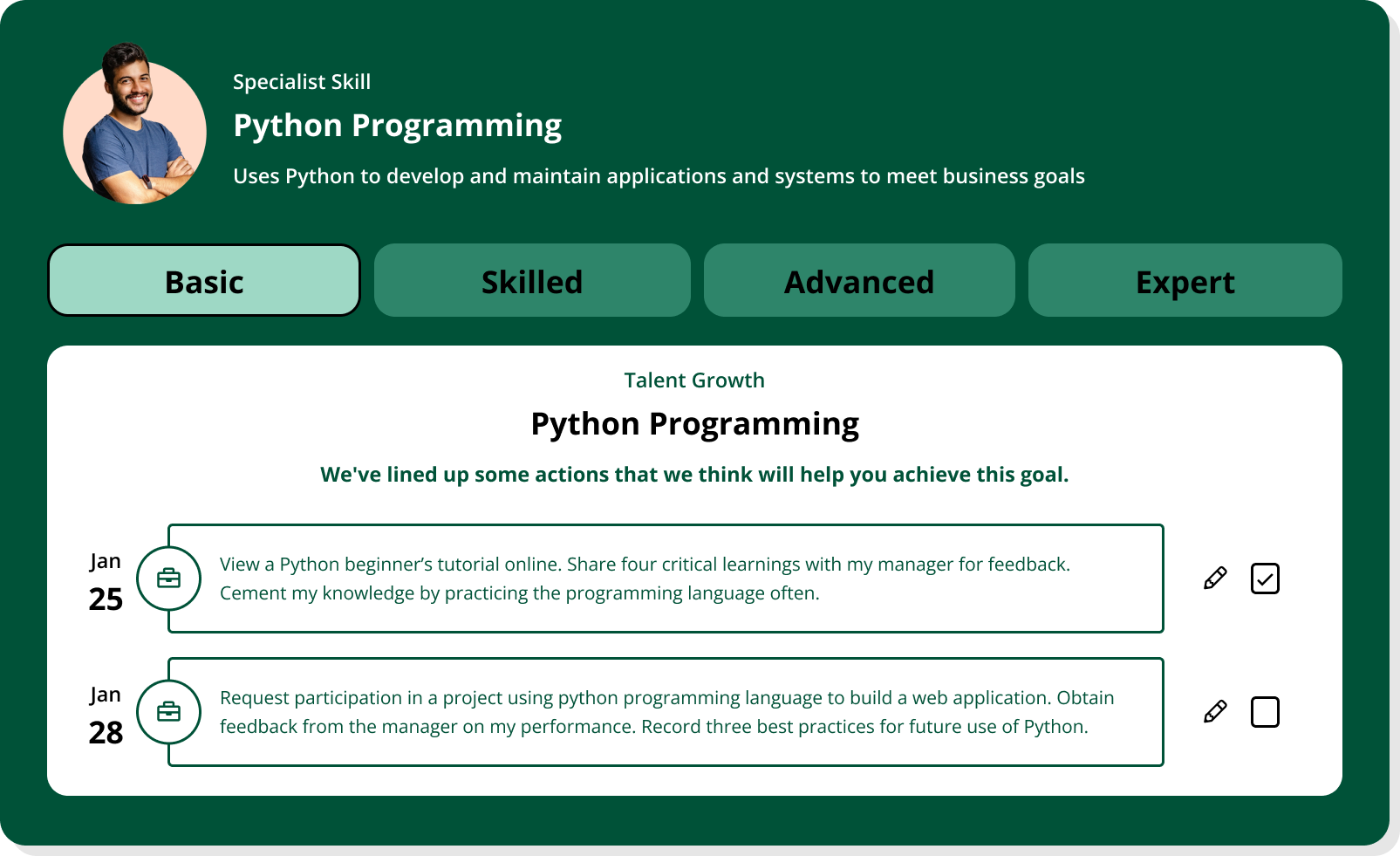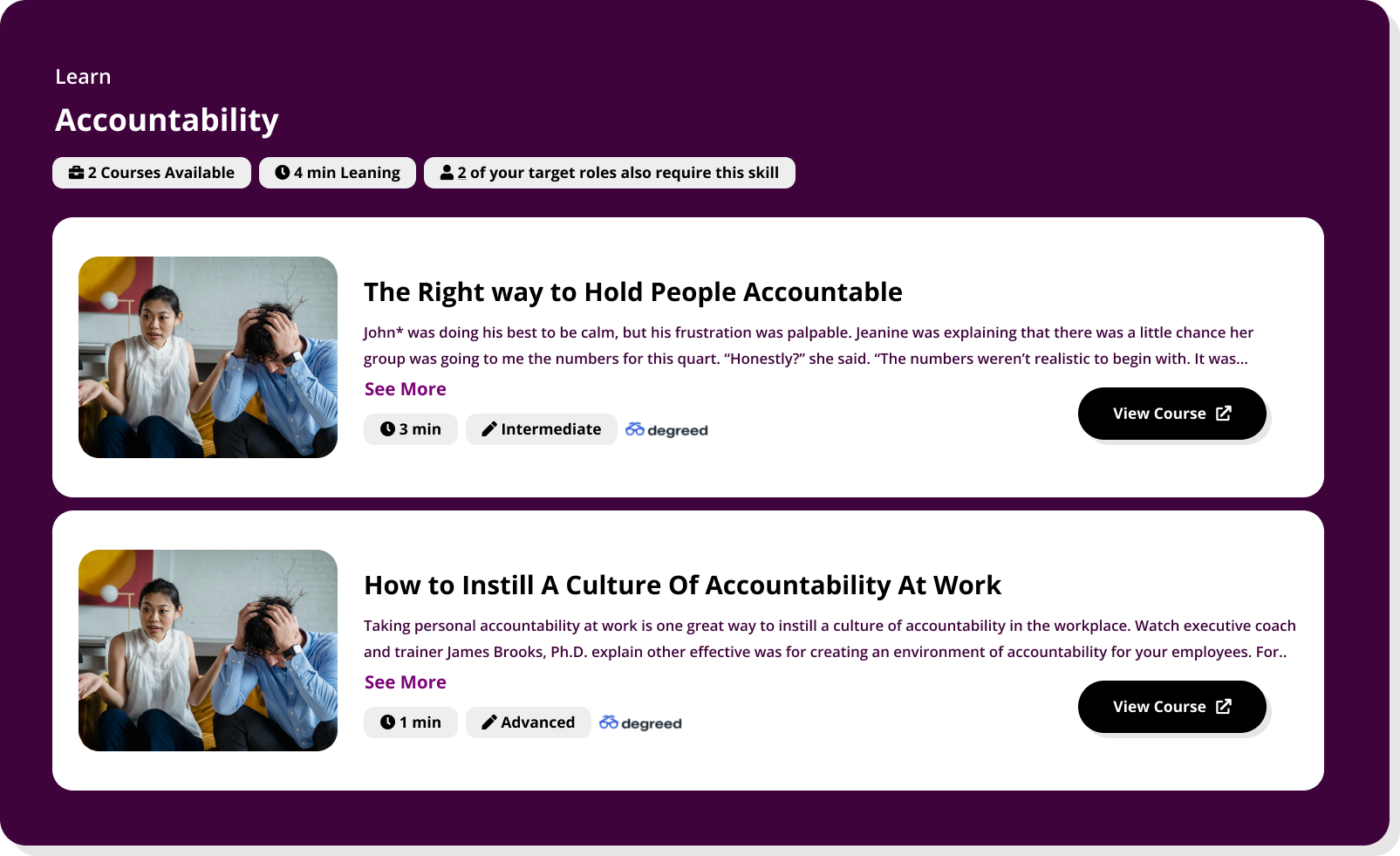With technology constantly evolving, the skills we have today will most likely need a refresh in the future… or may even become redundant altogether.
According to Citrix, 82% of employees and 62% of HR directors said that workers will need to reskill or upskill to maintain a competitive advantage. To keep up with the ever-changing demands of the workforce, upskilling and reskilling are going to be essential.
Providing training programs that enable employees to expand their skill sets and identify additional skills needed for career advancement will not only help strengthen your workforce but also lead to long-term growth and organizational success.
Employee talent development should be viewed holistically, in that it benefits both individual and organizational performance. When workers feel confident in their skills, organizations benefit from boosted employee performance and increased productivity.
Upskilling vs reskilling: What does each mean and what are their differences?
While both terms are often used interchangeably, there is a distinct difference between the two.
Upskilling involves the process of enhancing an employee’s existing skill set to enable them to grow in their current position and advance within their current career path. For example, when a web designer learns how to use a new piece of design software.
On the other hand, reskilling is the process of learning new skills to take on another position within the company. For example, when the same web designer learns social media skills so they can move into a role in the marketing team.
Career pathing supports these processes by allowing employees to visualize potential career paths, identify necessary skills, and understand the steps to achieve their career objectives.
The main difference is that upskilling builds on existing skills, whereas reskilling helps acquire new skills. However, both upskilling and reskilling are key to remaining competitive in today’s market.
Why do you need a reskilling and upskilling strategy?
The World Economic Forum predicts that by 2025, half of all employees will need reskilling to stay competitive. This projection underscores the urgency for continuous learning and adaptation. As technological advancements accelerate and industry demands shift, employees must update their skills to remain relevant.
For employees, acquiring new skills opens up a plethora of career opportunities, enhancing job satisfaction and career growth.
Employers, on the other hand, benefit from a more skilled and adaptable workforce, which translates to improved retention rates and overall organizational performance. By prioritizing upskilling and reskilling, organizations can ensure they remain competitive and resilient in the face of change.
Let’s dive into why upskilling and reskilling are essential for the future of work.
1. Keeping up with evolving technologies and technical skills
It’s no surprise that the pandemic has accelerated digital adoption across the globe and that it has had a huge impact on the world of work. Many organizations have undergone digital transformations where technology has replaced specific functions of the business.
According to research by Zippia, 56% of companies are currently prioritizing digital transformation worldwide as of 2021, and this is expected to continue.
As a result, workers will either have to reskill to find another role within the business or upskill to keep up with changing demands of their current role, ensuring that employees’ skills remain relevant.
This shift towards digital technology has also created new jobs that simply didn’t exist over 10 years ago – from app developers, social media managers, digital content creators, and more. As new technologies are on the horizon, people are looking to acquire skills within these fields to tap into new industries and stay competitive in the job market.
Automation is also expected to rise, replacing a large number of manual jobs. BBC predicts that up to 20 million manufacturing jobs around the world could be replaced by robots by 2030. As these jobs become redundant, many workers will need to reskill or upskill to find alternative work opportunities.
2. Adapting to changes easily and efficiently
There is constant change within the world of work, so ensuring employees can adapt to change and take on new challenges is a must. If your organization is needing to pivot due to industry changes, digital adoption, global pandemics, or the like, ensuring you have an upskilling and/or reskilling program will help ease the blow and lessen the learning curve for employees.
Data management company, NetApp, was in the middle of a business transformation from a traditional data storage business to a cloud company when they realized how important it was to evolve skills and roles across the organization.
Larry McAlister, VP of Global Talent at NetApp at the time, chose Fuel50’s AI-driven Talent Marketplace to help support employees through the transformation of the business, and provide them with upskilling and reskilling opportunities to grow and develop their skills. Larry says:
“We really want to say, in our internal marketplace, that skills are the new currency. There is growth to be had in so many different directions. […] We want a company full of learners, not a company full of knowers… and it’s all made possible by an internal marketplace with Fuel50.”
This equipped employees at NetApp with the skills and tools to prepare for change, and broadened their exposure to new opportunities within the organization, resulting in increased talent mobility, boosted agility, and ultimately, a future-proofed workforce.
3. Building a stronger workforce
Another key benefit of upskilling and reskilling your people is that it unlocks talent and gives workers the ability to hone their skills. Many employees are willing to expand their skill sets and take on greater responsibility, however, organizations aren’t providing enough development opportunities.
Through effective talent management, you should be able to pinpoint which employees are showing potential for advancement and give them the skill-building tools they will need to maximize their strengths and close skills gaps.
KeyBank is a great example of how a company has taken a proactive approach to upskilling and reskilling, ensuring both management and employees are better equipped for the future.
They deployed an enterprise-wide upskilling program so that dedicated employees who already know their culture can be reskilled, upskilled, and enabled to take on future job opportunities.
Carole Torres, SVP & Chief Learning Officer at KeyBank explained the importance of this for their employees:
“It’s a matter of how do we reskill and upskill current teammates who are already dedicated to KeyBank, know our culture, [and] have been with us for some time – so that they can meet the needs of what is required in new and different jobs in the future.”
As a result, KeyBank saw over 2,700 upskilling and reskilling actions take place to close skills gaps and a 60% increase in training participation and usage. With these numbers, it’s clear how beneficial these training programs can be in building a strong and highly skilled workforce.
4. Increasing retention, internal mobility, and career advancement
According to LinkedIn’s 2021 Workplace Learning Report, employees are twice as likely to stay if they have a chance to take on other roles within the organization.
In fact, many workers are already motivated to make internal job changes, with 35% of them currently using learning programs in the hopes of finding new opportunities within their organization. The motivation is there, so why not take advantage of it?
Providing upskilling and reskilling opportunities will not only boost across the board, but will also keep retention rates high, and even aid in attracting talent.
It goes beyond simply boosting skills, it’s about valuing your employees, enough to invest in their growth, development, and future. Carole Torres from KeyBank sums it up perfectly by saying:
“It’s critical to attract, grow and retain talent – it’s not just a nice thing to do for our teammates, but it’s critical to our success. Our leadership recognizes that people are our greatest asset and investing in our team members is paramount to ensuring that they are equipped to meet our client’s current needs as well as their future needs.”
5. Creating candidates through training programs instead of attracting candidates
The pandemic has highlighted the fact that workers are agile, fast learners, and willing to expand their skills. It’s now up to organizations to give them the chance to do just that. Enabling workers to upskill and reskill will result in them feeling valued, empowered, and motivated.
HR Analyst Josh Bersin points out that we need to shift to a world of “creating candidates” instead of “attracting candidates”.
“You have to hire people with the potential to grow and train them, create apprenticeships and internships to get young people, or move and reskill people inside your company to grow. These are new focus areas in HR, and some of the most powerful disciplines to grow your company.”
When you prioritize the development of your people, the benefits will flow throughout your organization, powering both individual and organizational growth and positively impacting bottom-line business metrics.
Support upskilling and reskilling through Fuel50’s skills intelligence
While Fuel50 isn’t a learning management system, it provides critical intelligence and infrastructure to guide upskilling and reskilling initiatives through its talent marketplace platform:
Map current vs. required skills
Fuel50’s AI-powered skills ontology identifies gaps between employees’ current skills and those needed for target roles or future business needs. This helps organizations prioritize which skills to develop through training programs.
Connect skills to learning opportunities
Fuel50 integrates with learning management systems to recommend relevant training content based on identified skill gaps. For example, when an employee explores a target role, they can immediately see what learning resources will help them develop the required skills.
Enable project-based skill development
Through Fuel50’s gig marketplace, employees can take on short-term projects to develop new skills in a practical setting. UCI saw high engagement with this feature as employees used projects to build capabilities in new areas.
Measure skills development impact
The platform’s analytics track how skills profiles evolve over time as employees complete learning programs and projects, helping organizations measure the effectiveness of their upskilling initiatives.
While other systems deliver the actual training, Fuel50 helps organizations identify what skills to develop, who needs to develop them, and whether development efforts are succeeding. This intelligence makes upskilling and reskilling programs more targeted and effective.














